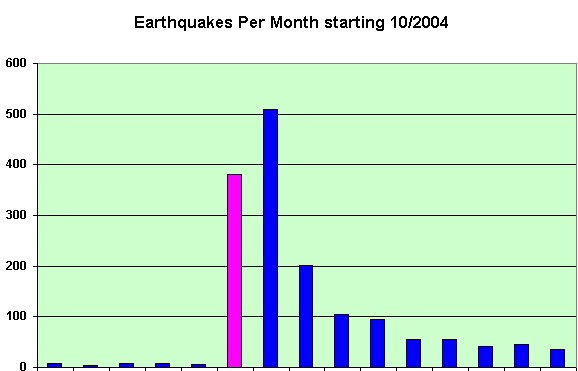I-MAG STS Corporation
In the three months prior to the 8.7 on March
28 there was an average of one 4.45
earthquake every 5 days. Then there were 120
earthquakes on the March 28th alone (purple
bar). To be sure, more than 80 were less than
5.0 and only there was only one 6.0. The next
day there were 19 aftershocks in the low 5s
and almost 150 in the 4s. On the 30th 5
aftershocks in the 5s and 64 in the middle 4s.
If one copies a column of a matrix and runs a
correlation calculation the answer will
trivially be 1. However, sometimes by shifting
the copied data up one or more rows (lagging)
a serial correlation (also known as
autocorrelation) can be found such that a
variable's past values can predict future
28 there was an average of one 4.45
earthquake every 5 days. Then there were 120
earthquakes on the March 28th alone (purple
bar). To be sure, more than 80 were less than
5.0 and only there was only one 6.0. The next
day there were 19 aftershocks in the low 5s
and almost 150 in the 4s. On the 30th 5
aftershocks in the 5s and 64 in the middle 4s.
If one copies a column of a matrix and runs a
correlation calculation the answer will
trivially be 1. However, sometimes by shifting
the copied data up one or more rows (lagging)
a serial correlation (also known as
autocorrelation) can be found such that a
variable's past values can predict future
values. Unfortunately, the correlation with past earthquakes is miserable. Ironically, were one to run time backwards the
aftershocks form a fine indicator that a large earthquake happened - at least on Nias. Our preliminary results indicate that
the next major earthquake will be in the straits between Sumatra and the Mentawai Islands. There are 70 islands in the
group so we will refine the location to near Siberut, Sipou amd North Pagai. These islands are roughly on a northwest
southeast diagonal between 1 and 3 degrees south and 98.5 and 100.5 degrees east. We are currently trying to assess the
significance of the three recent large earthquakes: 6.7 on September 20 at 8:31 (UTC); 7.0 on September 13 at 3:35 and 7.9 on
September 12 at 23:49. More to follow including semi-divisive non-Euclidean cluster analysis soon.
aftershocks form a fine indicator that a large earthquake happened - at least on Nias. Our preliminary results indicate that
the next major earthquake will be in the straits between Sumatra and the Mentawai Islands. There are 70 islands in the
group so we will refine the location to near Siberut, Sipou amd North Pagai. These islands are roughly on a northwest
southeast diagonal between 1 and 3 degrees south and 98.5 and 100.5 degrees east. We are currently trying to assess the
significance of the three recent large earthquakes: 6.7 on September 20 at 8:31 (UTC); 7.0 on September 13 at 3:35 and 7.9 on
September 12 at 23:49. More to follow including semi-divisive non-Euclidean cluster analysis soon.
